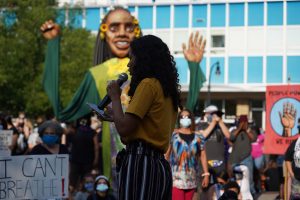In quarantine, social media becomes an even more essential tool
By Kaitlyn Busch, Riverside High (’21)
Aissa Dearing’s call to remove School Resource Officers from Durham Public Schools has more than 3,000 signatures, but this is no traditional petition. These signatures are in the form of Instagram comments.
“Just imagine if Martin Luther King had a Twitter,” joked Dearing, J.D. Clement Early College High (‘20). “Things would pop off!”

When a global pandemic coincides with groundbreaking momentum for social change, activists and journalists alike find their traditional methods to be decreasingly feasible while their work becomes more essential than ever. Social media provides an immediate, powerful yet imperfect means of organizing and sharing information.
Dearing is involved with the Youth Justice Project, a program affiliated with the Durham-based Southern Coalition for Social Justice. The Youth Justice Project has been advocating for reforms surrounding school policing for about a year and a half, she said. As someone who has always been in favor of removing School Resource Officers from schools, Dearing said that taking action as an individual and using Instagram to publish her open letter to the school board as well as the accompanying petition allowed her to take advantage of the moment.
“If (the Youth Justice Project) wanted to put out a letter like that, there would be a lot of processes and organizational things that they would have to go through,” Dearing said. “But as an individual, I could just kind of write down my thoughts and feelings and put it out there the same day. I wanted to capitalize on this moment, and because defunding the police isn’t such a controversial statement anymore, I definitely wanted to get my perspective out there.”
Dearing was focused on making her petition accessible and shareable rather than requiring signees to click a link and provide an email address. Her letter was reposted 200 times within the hour she published it to Instagram and garnered a response from the school district and board chairman Mike Lee.
While a statement reaffirming Durham Public Schools’ relationship with the Sheriff’s Department was admittedly not the response she had hoped for, Dearing said she was glad for her message to be recognized and amplified by the district. She organized the March for Black Students in response to the statement.
“I’ve been encouraging people to tag Durham Public Schools (in the Instagram comments) in order to almost force them to make a statement on this,” she said. “It got the people that I wanted to see it to see it, which I don’t think would have happened without using social media.”
In a pre-social media time, it would have been much more difficult for Black activists to generate the awareness and momentum surrounding social issues that they have, according to Daniel Kreiss, professor of political communication in the UNC Hussman School of Journalism and Media. Today, individuals have the ability to film injustices that they witness, which social media platforms and, consequently, news organizations bring to a broader audience.
“Social media makes organizing easier,” Kreiss said. “It lowers the cost of bringing people out into the streets. It’s a technology of witnessing, but it’s also a technology of organization. I think those two things make it a really powerful set of tools for the current Black Lives Matter movement that’s captured international attention.”
This capacity to witness and organize is precisely why social media can be a valuable sourcing tool for journalists, especially during a pandemic, according to Lois Boynton, professor of ethics and public relations in the UNC Hussman School of Journalism and Media.
“(Social media platforms) become sources for you when it’s harder to talk to somebody in person,” Boynton said. “Particularly if you’re looking within a specific demographic … it gives you a ready-made handy group to get sources from and then also very quickly and expeditiously get your information out.”
Boynton and Kreiss agree that the two-way, conversational nature of social media can also aid journalists in accessing feedback and gauging public opinion and interests.
“That element that seems to be rather significant right now is the ability to almost create a community,” Boynton said, “or create some dialogue with a community, which I think ultimately could help in building more trust in media.”
Journalists and activists cannot be completely reliant on social media, however. As an activist, Dearing said she has concerns about the increasing interconnectedness of social media and activism. She worries about her message being distorted.
“I saw a couple of story reposts from the vigil (for George Floyd) that I helped to plan a couple weeks ago,” she said. “Someone reposted it saying, ‘This is the right way to protest,’ and that was not the point. I’m a very keen believer that there’s no ‘right way’ to protest and you can’t tell people how to heal after a national tragedy.”
While she notes that stay-at-home restrictions have allowed some people to become involved for the first time, Dearing also emphasized her concerns about the accessibility of virtual activism.
“I’ve lost a few members of my team because they simply do not have access to Zoom or whatever communication platform we’re using,” she said. “It’s kind of this juxtaposition. There are definitely some people who no longer have access to activism during this time, but now there’s a lot of people that have access because they’re able to be activists in their own home.”
Kreiss said that social media can also be weaponized by targets of social change against activist movements.
“What we’ve seen, for instance, is that for all the ways social media support witnessing and organizing, they also support police forces engaging in things like surveillance,” he said. “The other piece…is that when misinformation comes to play, what happens is that those people who are resistant to change can often try to circulate false information, disinformation, in order to muddle the claims of the movement.”
